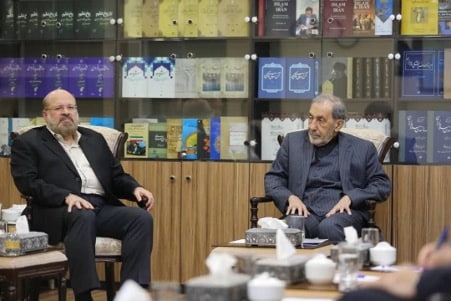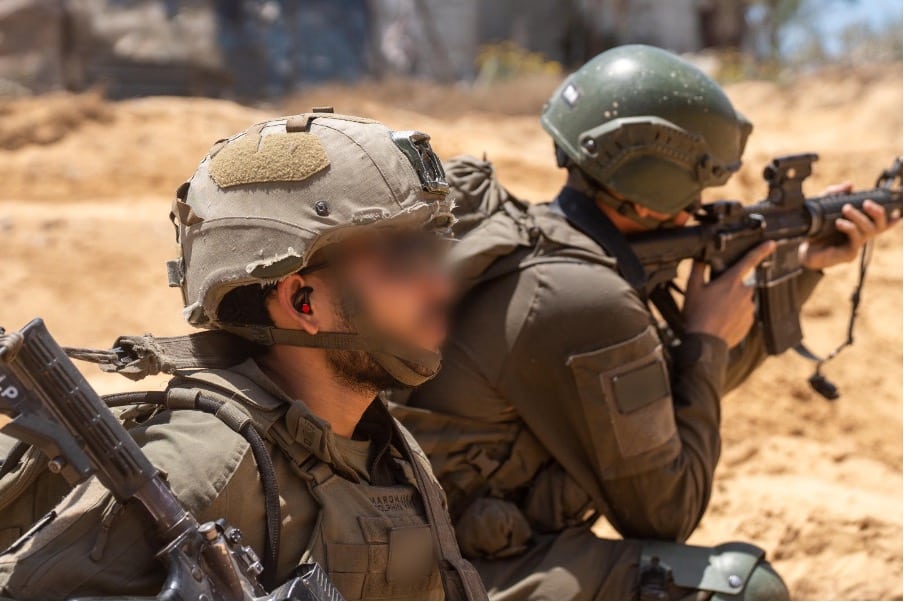
Overview
- U.S. Middle East Envoy Steve Witkoff criticized Hamas for submitting what he termed “backward” revisions to Washington’s hostage exchange framework. In its reply, Hamas stipulated that Israeli captives must be released throughout the proposed 60-day truce
- The Gaza Humanitarian Fund which was established to exclude Hamas from the humanitarian aid distribution process, has distributed 23,040 food boxes—equating to around two million meals, with each box intended to feed an average of 5.5 people for 3.5 days.
- Despite Hamas’s calls not to cooperate with the new distribution mechanism, tens of thousands of Gazans tens of thousands of Gazans defied Hamas to access the aid.
- Bedouin leader Yasser Abu Shabab has formed a militia of 100–150 armed men tasked with securing food convoys, Red Crescent workers, and even assisting the IDF in the searches of Gaza buildings.
- Osama Hamdan, a senior Hamas political leader in Lebanon, declared on camera: “We expect our great people to thwart the method of receiving aid today, just as they thwarted it yesterday. We trust that our people will endure hunger and not extend their hands to the occupier asking for aid.”
- Lebanese Prime Minister Nawaf Salam declared on CNN his willingness to normalize relations with Israel.
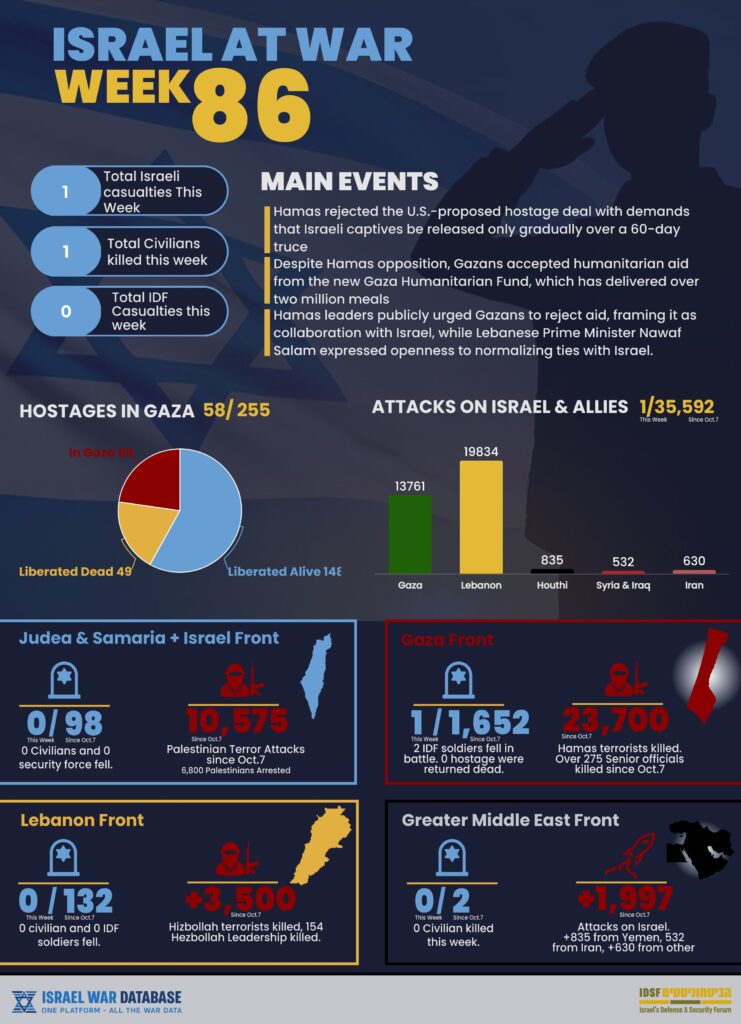
Gaza
Hostage Deal
- Under the Witkoff proposal, a 60-day ceasefire would begin with the release of 5 live hostages and 9 bodies on Day 1, followed on Day 7 by another 5 live hostages and 9 bodies (totaling 10 live, 18 bodies). By Day 10, Hamas would provide a detailed medical report on remaining captives. Israel would withdraw from parts of the territory gained during the war, while President Trump would proclaim the ceasefire under U.S.-Egypt-Qatar guarantees. In exchange, Israel would free 125 “world” prisoners and 1,111 Gazan detainees for the live hostages; and 180 Gazan bodies in exchange for the bodies of the deceased captives.
- U.S. Middle East Envoy Steve Witkoff criticized Hamas for submitting what he termed “backward” revisions to Washington’s hostage exchange framework. In its reply, Hamas stipulated that Israeli captives must be released throughout the proposed 60-day truce—a condition meant to prevent any resumption of Israel’s military campaign—and demanded explicit assurances that hostilities would not restart once those two months concluded. Unlike Witkoff’s original plan, which did not require a full IDF withdrawal from all of the strip or establish a permanent ceasefire, Hamas appended its own conditions. Israeli officials acknowledged acceptance of the updated Witkoff framework for freeing hostages but noted that Hamas still “clings to its refusal” to meet core demands. According to local media (N12, Ynet), Hamas leaders quietly pushed for an up to seven-year ceasefire, effectively preserving their control over Gaza and allowing for rearmament during that period. Despite publicly claiming they have not rejected the U.S. proposal—as stated by senior official Basem Nāʾim to Reuters—Hamas’s additions ensure the group remains unwilling to comply with the deal’s essential terms.
Humanitarian Aid
- More than 250,000 Palestinians were evacuated from Jabalya to designated shelter zones, but humanitarian conditions remain dire. Field reports describe Thursday night as one of the most intense since the campaign began, with bombardments and urban fighting intensifying civilian dislocation as Hamas militants cling to the dwindling civilian infrastructure, to use as human shields.
- UN aid chief Tom Fletcher publicly retracted his claim that 14,000 infants faced imminent death within 48 hours—a statement later disproven by COGAT—yet he has not withdrawn the assertion that 10,000 aid trucks were “cleared and ready” at the border. In reality, Israel has permitted only 900 aid trucks into Gaza over the past week, of which 135 out of 238 dispatched from Kerem Shalom were looted by civilians and unaffiliated armed groups.
- Despite Hamas’s calls not to cooperate with the new distribution mechanism, tens of thousands of Gazans traveled south to Tel Sultan through the “right corridor,” passing through five holding pens designed to regulate the flow of civilians before they reached the distribution area and exited via the left corridor. According to eyewitness testimony, the wait could last an hour and a half, after which each family received a package intended to sustain five people for one week, containing flour, cooking oil, sugar, pasta, tahini, canned meat, various preserves and a sweet treat. Over the course of Tuesday, 8,000 packages were distributed—equivalent to 462,000 meals. When crowds surged, Gazans breached the fences and stormed the distribution center; the American team retreated, and some aid workers’ vehicles were looted. In response, U.S. personnel fired warning shots into the air, and an IAF helicopter discharged flares near looters to restore order—distribution resumed about an hour later. Simultaneously, in Nuseirat camp, mass looting of aid trucks took place.
- The Gaza Humanitarian Fund which was established to exclude Hamas from the humanitarian aid distribution process, has distributed 23,040 food boxes—equating to around two million meals, with each box intended to feed an average of 5.5 people for 3.5 days—yet only about 40 trucks’ worth of supplies arrived. Some beneficiaries publicly thanked Trump and Netanyahu on camera, symbolically shattering Hamas’s “barrier of fear.” Under immense pressure from losing its monopoly on food aid, Hamas offered a compromise: in a Wednesday statement it accepted the Witkoff framework and pledged to release 10 hostages (five alive, five deceased) as a gesture to open negotiations for ending the war. On that day, 121 trucks entered the Strip. Meanwhile, Gazans openly cursed Hamas, stormed World Food Porgramme warehouses (actually controlled by Hamas), and looted the giant Marzi camp flour depot—even though Hamas gunmen fired on them, killing five civilians.

Osama Hamdan, a senior Hamas political leader in Lebanon, declared on camera: “We expect our great people to thwart the method of receiving aid today, just as they thwarted it yesterday. We trust that our people will endure hunger and not extend their hands to the occupier asking for aid.”
In a further sign of shifting power dynamics, reports emerged that a Bedouin leader Yasser Abu Shabab has formed a militia of 100–150 armed men tasked with securing food convoys, Red Crescent workers, and even assisting the IDF in the searches of Gaza buildings. They are serving as the de facto security for incoming aid trucks. Abu Shabab, once imprisoned by Hamas on drug- and theft-related charges, has recruited primarily ex-officers of Palestinian security forces, directly challenging Hamas’s authority. Hamas, for its part, accuses him of looting aid trucks and colluding with Israel. According to Reuters, Hamas is unable to operate in those sectors of Rafah under Abu Shabab’s influence. If reports are accurate, this emerging force could serve as the foundation for replacing Hamas’s rule with another local rule once hostilities cease.
Operational
- The IDF estimates that Operation Gideon’s Chariots will continue for another two months, during which it currently controls 40% of the Strip and aims to seize and “clear” an additional 35%, thereby confining the remaining civilian population to just 25% of the territory. Most residents have fled Khan Younis for the Mawasi area, where roughly 750,000 Palestinians now live; only a few hundred militants remain in Khan Younis itself. Despite dwindling resources, Hamas still possesses thousands of rockets and mortar shells and remains a threat to Israeli security.
Diplomatic
- Saudi Arabia has been quietly crafting a proposal—developed with French assistance—to disarm Hamas terrorists, opening the door to their demobilization; Saudi envoys have reportedly engaged in direct talks with Hamas leadership to advance this initiative.
Domestic Israel
- Defense Minister Israel Katz and Finance Minister Bezalel Smotrich announced a plan to establish 22 new Israeli residential communities throughout Judea and Samaria (West Bank), including the Jordan Valley, aimed at reinforcing Israel’s strategic grip on the region.
- Concurrently, after extensive testing, the “Iron Beam” laser defense system has been declared operational under Israel’s Maf’at and Ministry of Defense. Integrated into the IAF and Rafael’s multi-layered air defense network, it follows dozens of successful UAV interceptions, many of which targeted Hezbollah drones.
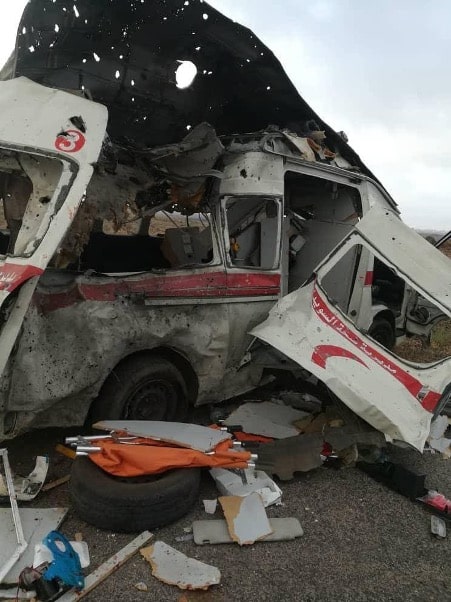
Judea and Samaria
- Over the past week, Israeli security forces conducted raids on foreign exchange shops across several Palestinian cities, including Ramallah and Nablus, alleging that their parent company maintained “terrorist affiliations.”
- IDF arrested 80 wanted suspects, seized an array of weapons, and confiscated 7 million ₪shekel in cash linked to terrorist financing in the Judea and Samaria, which led to the ramping up of IDF deployments ahead of the upcoming Shavuot holiday.
- In a tragic incident, 15-day-old baby Ravid Haim Gez—whose mother was fatally shot by a Palestinian militant en route to deliver him—succumbed to his injuries shortly after birth.
- Israel blocked a planned Arab foreign ministers’ meeting in Ramallah—which would have included dignitaries from Jordan, Egypt, Saudi Arabia, Qatar, and the UAE—labeling it a provocative maneuver given the PA’s continued refusal to condemn the October 7 massacre.
Lebanon
Diplomatic
- Lebanese Prime Minister Nawaf Salam declared on CNN his willingness to normalize relations with Israel. Concurrently, a Wall Street Journal report on May 28 revealed that 80% of Hezbollah’s weapon stockpiles south of the Litani River have been confiscated through joint IDF–Lebanese Army operations, signaling unprecedented cooperation between the two adversaries in curbing Hezbollah’s military infrastructure.
- Senior Hezbollah figure Wafiq Safa, once close to Nasrallah and now head of the group’s liaison and coordination unit, met with UN Special Coordinator Jeanine Hennis-Plasschaert. They discussed UNSC Resolution 1701, recent developments in southern Lebanon, and “the need to maintain regional stability.” Safa—implicated in Rafik Hariri’s assassination, drug trafficking, and money laundering—survived an IDF assassination attempt in October 2024 and exemplifies Hezbollah’s nexus of terror and narcotics.
Operational
- An Israeli airstrike in southern Lebanon killed a commander of the Radwan Force, prompting Lebanese politicians to call for Hezbollah’s disarmament. Of the 16,000 buildings destroyed in border villages, only 50 show signs of reconstruction; most remain leveled and desolate. By contrast, 60–70 percent of Galilee residents have returned home, with many more expected before the new school year.
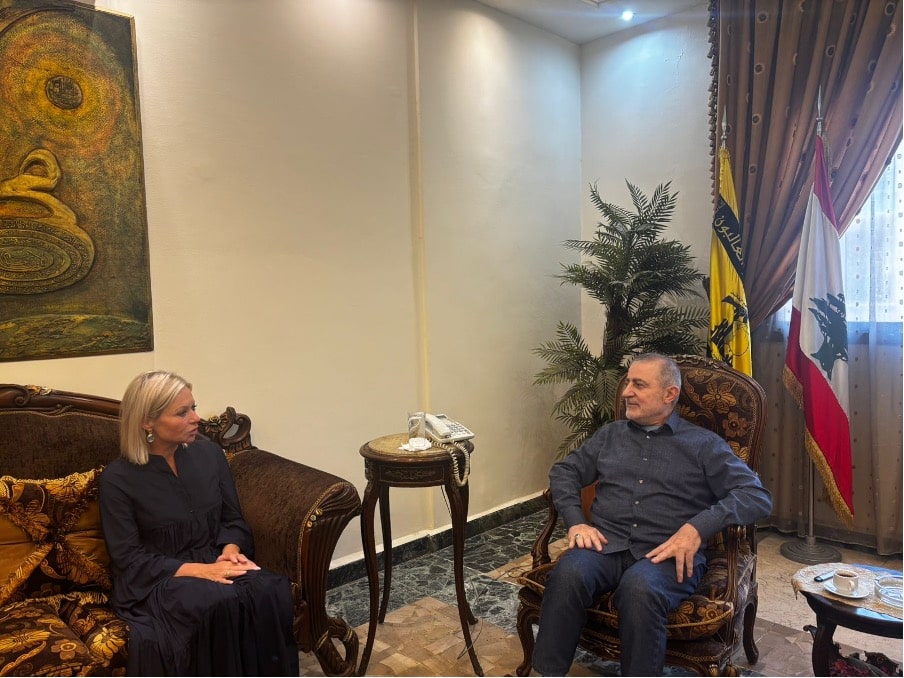
Syria
Military Activity
- In a strategic move to neutralize threats to regional shipping routes, the IDF conducted an airstrike on ammunition depots near Latakia’s coast, destroying anti-ship missiles and surface-to-air missile components that endangered Israeli navigation.
- According to Asharq al-Awsat, security cooperation between Syria and Jordan is deemed essential amid fears that ISIS cells could regroup in Syria’s deserts to launch attacks on neighboring countries like Jordan. Jordanian sources warn of “serious concerns” over renewed terror activity and infiltration of local communities, noting that some ISIS or sympathizing elements are hostile to Hay’at Tahrir al-Sham’s leadership and fear Syria’s collapse. ISIS has, for the first time, claimed responsibility for a suicide car bombing in As-Suwayda governorate that killed and wounded seven regime personnel.
Diplomacy
- The U.S. and EU are in advanced stages of lifting sanctions on Syria, though the EU will retain measures against individuals implicated in ethnic persecution, human rights abuses, human trafficking, weapons trade, or previous Assad-regime officials. Despite these sanctions relief moves, Hay’at Tahrir al-Sham leader al-Julani continues to appoint his associates—accused of similar crimes—to key positions, including in the military.
- The U.S. embassy in Damascus has reopened.
- Reuters reports that, under UAE mediation, Israel and Syria are holding direct security talks in Quneitra to prevent escalation.
- Meanwhile, on the Druze side of the Golan Heights, the IDF’s new medical facility in Khader has treated 500 Druze patients, bolstering Israel’s strategic ties with local communities.
- Saudi Foreign Minister Prince Faisal bin Farḥān arrived in Damascus accompanied by a senior economic delegation, including officials from the Saudi Ministry of Finance and the Foreign Ministry’s economic and development offices. During his visit, he is slated to meet Syrian President Al-Julānī and Foreign Minister Asʿad al-Shibānī, underlining a revival of economic ties and signaling Riyadh’s broader regional outreach despite lingering political tensions.
- The commander of Syria’s Kurdish-led forces, Mazloum Abdi, announced that his group, the Syrian Democratic Forces (SDF), is in direct contact with Turkey and is open to improving ties, even considering a meeting with President Recep Tayyip Erdoğan.
- Meanwhile, the U.S. Special Envoy for Syria held discussions with Hay’at Tahrir al-Sham’s leader al-Julani at the presidential palace in Damascus, urging the signing of a non-aggression pact with Israel.
- On the economic front, al-Julani’s administration has already embarked on a reconstruction initiative, signing a $7 billion memorandum of understanding with energy firms from Turkey, Qatar, and the UAE to rebuild Syria’s power infrastructure—projects projected to employ up to 300,000 Syrians.

| Source: al-sharq news on telegram, https://t.me/AsharqNewsSYR
Yemen
- The IAF struck the Sana’a port, reopened just ten days earlier, as the Houthis acknowledged at least 24 UAV and missile launches toward Israel in May. In “Operation Golden Ornament,” launch sites were disabled and Yemenia’s fourth and final aircraft was destroyed upon landing from Jordan. U.S. Special Envoy for Yemen, via Oman, is attempting to renew negotiations for the release of UN personnel and a return to peace talks with Saudi Arabia, though attacks on Israel remain unaddressed.
- The Institute for the Study of War reports that the Houthis are enhancing UAV capabilities: the Shahed-238 (jet-powered) can reach 600 km/h, hitting Eilat in two hours and the central Red Sea in 48 minutes, versus the slower Shahed-136 at 185 km/h (nine hours to Eilat, 1 h 20 m to the Red Sea), making it harder to detect and intercept as speed increases.
Iran
Nuclear Deal Talks
- The U.S. and Iran are negotiating an interim agreement under which Iran would freeze uranium enrichment for one year, export its stockpile of highly enriched uranium, and permit U.S. inspectors at its nuclear sites, in return for lifting the threat of Israeli strikes and unfreezing billions in assets overseas. President Trump has publicly endorsed the deal and warned Prime Minister Netanyahu not to sabotage the talks. According to Axios, on May 22, Trump phoned Netanyahu, threatening repercussions if he undermined the process; on May 26, Israel’s Strategic Affairs Minister and Mossad Chief traveled to Washington to meet with the Vice President, CIA Director, and Witkoff to discuss Iran.
- The International Atomic Energy Agency report disclosed alarming figures: in recent months, Iran has ramped up its 60% enriched uranium stockpile by an additional 133.8 kg, bringing the total to over 400 kg—sufficient material for approximately ten nuclear weapons. In parallel, its stock of 20% enriched uranium has reached 274.5 kg, illustrating Tehran’s accelerating nuclear enrichment program.
International
- At the UN Security Council, the United States took a firm stance in support of Israel by rejecting unilateral recognition of Palestinian statehood—explicitly rebuffing France’s push for such a move.
- French Foreign Minister Jean-Noël Barrot reiterated Paris’s call to implement a two-state solution and announced that France, in partnership with Saudi Arabia, will co-host a UN conference in June to further the Israeli-Palestinian peace process. Meanwhile, French President Emmanuel Macron signaled in April that Paris could officially recognize Palestine in June unless Israel significantly ameliorates Gaza’s humanitarian crisis.
- United Kingdom is weighing sanctions against specific Israeli ministers—namely, National Security Minister Itamar Ben-Gvir and Finance Minister Bezalel Smotrich—in a move reported by The New York Times.
- On May 26, Spanish Foreign Minister José Manuel Albares urged the international community to consider sanctions against Israel to compel an end to the Gaza war. Malta announced plans to recognize the State of Palestine next month, with Prime Minister Robert Abela affirming his country’s intention to make the declaration at a France–Saudi–hosted New York conference. On May 30 in Singapore, French President Emmanuel Macron labeled Palestinian statehood recognition a “moral imperative” and warned that Europe would harden its stance toward Israel unless Gaza’s humanitarian situation improves.
- Foreign Minister Abbas Araghchi declared that “Saudi Arabia holds an important place in our regional neighborhood policy.” Emphasizing Iran’s commitment to Iran–Saudi rapprochement, he vowed to “continue our fraternal relations without allowing any disruption.” Despite this diplomatic olive branch, Iran remains locked in a struggle for regional hegemony, seeking to undermine the Abraham Accords, isolate Israel, and leverage Gulf states’ fear of a nuclear-armed Iran to forge dependencies through diplomatic ties—all while advancing its own nuclear weapons ambitions.
Global Jihad
- On May 29, al-Nabāʾ, the weekly magazine of ISIS, issued a call to carry out jihad and suicide attacks against “infidels” during the first ten days of Dhu al-Ḥijjah, the Hajj pilgrimage month. The editorial specifically urged “lone wolf” assailants to strike, emphasizing the use of individual initiative rather than organized cells.

